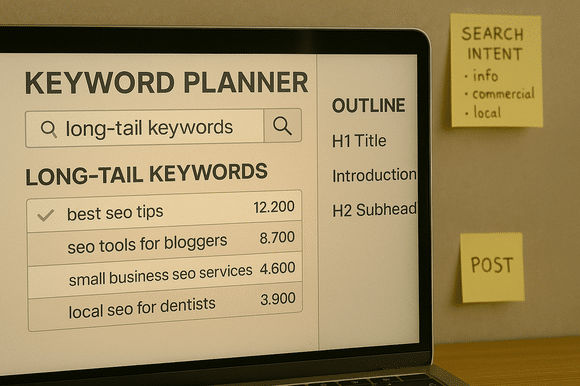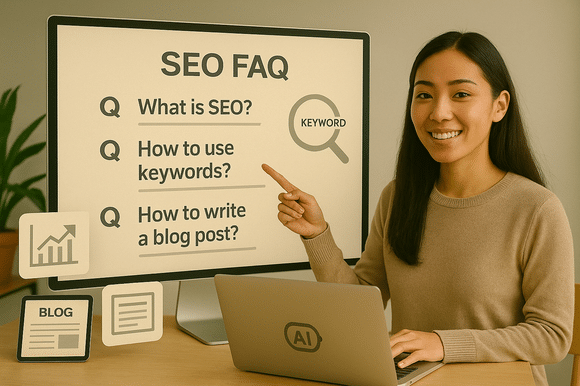Bloggers & Writers

Elevate Your Content with AI-Powered SEO Optimization
Creating great content is no longer enough — it also needs to be optimized for search engines to gain visibility. For bloggers and writers, understanding how to improve your SEO can mean the difference between getting buried in search results or standing out online. Yet many content creators struggle to bridge the gap between compelling writing and strategic SEO. That’s where systems like SEOBoostAI come in — combining intuitive workflows with AI content creation tools to streamline your writing process and align it with search engine best practices.
This article will show you how to build a strong foundation in SEO content creation by integrating smart keyword placement, natural optimization, and AI support that complements your voice and message. Whether you're just starting out or looking to improve blog performance, you’ll learn how to apply content creation and SEO together to consistently produce articles that rank higher and engage your readers. If you're ready to write with clarity, strategy, and purpose, this guide will help you turn every post into a search-optimized asset.
Traditional Writing vs. Search-Optimized Writing

Traditional writing focuses primarily on storytelling, voice, and message — essential components for bloggers and writers. But in the digital landscape, even the most compelling content can get buried if it's not optimized for search. Today’s content creators must do more than express ideas — they must ensure their work is aligned with what users are searching for. Search-optimized writing adds that missing link, combining creativity with strategy so that your content reaches the people who need it most.
Search-optimized writing starts with understanding user intent, then guiding that intent through structure, readability, and relevance. By using tools that support seo content creation, writers can adapt their process without sacrificing authenticity. It means applying purposeful keyword placement — such as how to improve your SEO — using headers to signal topic hierarchy, and making content scannable and mobile-friendly. The result is writing that remains engaging but performs better in search rankings.
Unlike the rigid keyword stuffing methods of the past, modern SEO practices reward content that’s helpful, organized, and matched to reader needs. With the right workflow — especially when powered by AI content creation tools — writers can maintain their natural tone while still producing articles that rank. Search engines prioritize quality, and that includes clarity, structure, and topic authority. When you align your writing with these principles, you’re no longer just a writer — you're a strategist with a scalable advantage.
By combining traditional writing strengths with modern optimization tactics, bloggers can turn passion projects into performance-driven platforms. Content creation and SEO are not opposing forces — they’re two sides of the same success strategy.
The Blogger’s Challenge – Great Content, Low Visibility

Traditional writing focuses primarily on storytelling, voice, and message — essential components for bloggers and writers. But in the digital landscape, even the most compelling content can get buried if it's not optimized for search. Today’s content creators must do more than express ideas — they must ensure their work is aligned with what users are searching for. Search-optimized writing adds that missing link, combining creativity with strategy so that your content reaches the people who need it most.
Search-optimized writing starts with understanding user intent, then guiding that intent through structure, readability, and relevance. By using tools that support SEO content creation, writers can adapt their process without sacrificing authenticity. It means applying purposeful keyword placement — such as how to improve your SEO — using headers to signal topic hierarchy, and making content scannable and mobile-friendly. The result is writing that remains engaging but performs better in search rankings.
Unlike the rigid keyword stuffing methods of the past, modern SEO practices reward content that’s helpful, organized, and matched to reader needs. With the right workflow — especially when powered by AI content creation tools — writers can maintain their natural tone while still producing articles that rank. Search engines prioritize quality, and that includes clarity, structure, and topic authority. When you align your writing with these principles, you’re no longer just a writer — you're a strategist with a scalable advantage.
By combining traditional writing strengths with modern optimization tactics, bloggers can turn passion projects into performance-driven platforms. Content creation and SEO are not opposing forces — they’re two sides of the same success strategy.
How AI Tools Help Writers Overcome SEO Gaps

Many writers believe SEO is too technical or time-consuming to master — and for good reason. Between keyword research, metadata, search intent, formatting, and content structure, the process can feel overwhelming. But this is where AI content creation tools change the game. By simplifying complex tasks and guiding writers through optimization in real time, AI tools make SEO accessible even for those with no technical background. They shift the focus from trial-and-error to a clear, repeatable strategy that improves results with every post.
Platforms like SEOBoostAI take this further by combining writing support with built-in SEO logic at every phase of content creation. From outlining articles to integrating keywords, these tools help you stay focused, strategic, and consistent. You’re not just generating content — you’re crafting optimized frameworks that meet both reader expectations and search engine requirements. This means improved visibility, higher engagement, and stronger authority over time.
These tools also help close knowledge gaps that hold many bloggers back. Unsure where to place a keyword? How to write a headline that gets clicks? When to link internally or adjust for readability? With SEOBoostAI’s integrated workflow, you get real-time prompts and formatting support — without compromising your natural writing voice. It’s like having a strategist and editor by your side.
For writers looking to scale or stay competitive, AI is more than a convenience — it’s a strategic advantage. It saves time, reduces friction, and helps you publish content that’s not just valuable — but also visible. When content creation and SEO come together in one guided system, your writing doesn’t just get finished — it gets found.
A Simple SEO Workflow for Consistent Results

For bloggers and writers, success with SEO isn’t about mastering every algorithm update — it’s about following a workflow that delivers consistent, repeatable results. A streamlined system removes the guesswork from SEO content creation and helps ensure each article you publish is discoverable, engaging, and aligned with search intent. With the right process and tools in place, you can turn every piece of content into a traffic-generating asset — without having to become an SEO expert.
Start with audience-intent alignment. Every high-performing post begins by understanding what your audience is actively searching for. AI tools like SEOBoostAI simplify this by suggesting relevant, trending long-tail keywords — such as how to improve your SEO — and helping you shape your topic around those queries. This ensures your content starts strong, solves a real problem, and matches the user’s original search purpose.

Next, move into SEO-structured outlining. Rather than writing from scratch, AI-assisted platforms help you create a smart structure using headings, keyword groupings, and internal link prompts. You’ll be guided through formatting decisions that increase readability, lower bounce rates, and satisfy search engine expectations. Each H2, paragraph, and callout is intentionally crafted to reinforce both clarity and relevance — essential for long-term ranking power.
From there, use optimization-by-design to fine-tune your content. AI workflows check keyword density, highlight missing SEO elements, and guide your use of meta titles, descriptions, and internal links. You’re notified when a keyword like AI content creation tools is underused or when a heading needs adjustment — allowing you to refine in real time rather than after publishing. This reduces errors and increases overall publishing confidence.
The final step is repeatability at scale. When content creation and SEO are integrated into a single process, you can focus more on creativity and less on optimization stress. Whether you’re building a weekly blog or scaling a niche authority site, having a simple system in place means you no longer have to wonder if a post will perform — you’ll know it was built to.
From Voice to Visibility – Writing That Still Sounds Human

One of the biggest concerns bloggers and writers have when optimizing for search is losing their voice. The fear is that by focusing on keywords, structure, and algorithmic rules, their writing will become robotic or generic. But the truth is, when done right, SEO content creation actually amplifies your voice — it doesn't erase it. Visibility doesn't require sacrificing authenticity; it requires aligning your natural expression with search-friendly formatting and intent.
AI tools like SEOBoostAI are designed to support this balance. Instead of forcing you into rigid templates, they offer structure and optimization recommendations that adapt to your tone, style, and writing goals. For example, they help you integrate terms like how to improve your SEO within the flow of your content — not as disruptive insertions, but as value-enhancing elements that naturally belong in the conversation you’re having with your reader.
What makes AI content creation tools so effective is their ability to preserve nuance. They can distinguish between instructional and narrative tone, adjust formatting based on content length and complexity, and suggest improvements that boost clarity without flattening personality. This means your metaphors, stories, and analogies don’t get stripped away — they’re shaped and supported so they resonate with both readers and search engines.

More importantly, these tools reinforce consistency across your content portfolio. As your voice becomes more recognizable, SEOBoostAI ensures it also becomes more visible — helping you maintain emotional impact while optimizing structure, headlines, keyword usage, and semantic flow. With the right system, content creation and SEO no longer feel like competing priorities. Instead, they work together to elevate every word, allowing your message to reach further without sounding artificial or formulaic.
Writers who embrace this approach don’t just produce content — they build presence. They don’t lose their voice in the noise; they rise above it, with search-optimized articles that sound like them and perform like pro-level SEO assets. That’s the sweet spot: authentic writing, strategically enhanced for visibility.
Final Thoughts – You Don’t Have to Do It Alone

Creating great content is hard enough. Trying to make it search-friendly, technically optimized, and strategically aligned on your own can feel overwhelming — especially if you’re juggling publishing schedules, growing an audience, or building a brand. The good news is, you don’t have to figure it all out by yourself. With platforms like SEOBoostAI, the path to visibility, growth, and consistency becomes manageable — and even enjoyable.
Whether you're a new blogger or a seasoned writer, the right system can turn confusion into clarity. SEOBoostAI helps you shift from scattered, unstructured publishing to a unified process built on SEO content creation best practices. From the moment you select a topic, the platform walks you through keyword targeting, semantic structuring, and intent-matched formatting — giving you confidence that your post is engineered to succeed.
Let’s say you’re unsure how to use a keyword like how to improve your SEO without sounding forced. SEOBoostAI shows you natural placements within intros, headers, and transitions — even suggesting ways to phrase subtopics so they serve both readers and search engines. Or maybe you're struggling with how to end a post or optimize for readability. Built-in prompts, formatting cues, and optimization feedback guide you in real time, turning potential roadblocks into simple steps.
AI content creation tools aren’t here to replace your voice — they’re here to support it. They eliminate the technical guesswork, reduce manual editing, and free up mental space so you can focus on creativity. Over time, you not only write better content — you write it faster, with more strategic intent, and with fewer post-publish regrets.
Ultimately, content creation and SEO aren’t two separate jobs — they’re a single process when you use the right tools. You don’t have to be a one-person SEO team, or spend hours second-guessing every sentence. With SEOBoostAI guiding the way, you can publish with purpose, scale your output, and finally gain the visibility your writing deserves. Because no one builds authority alone — but with the right system, you don’t have to.
Frequently Asked Questions

How do I optimize a blog post without making it sound robotic?
Focus on writing naturally first, then integrate keywords like how to improve your SEO during the editing phase. Use AI content creation tools that suggest keyword placement within readable, user-focused language. The goal is to enhance clarity, not force in jargon. Tools like SEOBoostAI help maintain your tone while improving structure and keyword alignment.
Can I use SEOBoostAI even if I have no technical SEO experience?
Absolutely. SEOBoostAI is designed for writers and bloggers without a technical background. It walks you through topic targeting, on-page formatting, internal linking, and seo content creation best practices — all without overwhelming you with jargon or code. You’ll be following professional SEO standards without needing to learn them manually.
What’s the best way to start ranking my blog posts?
Start with a simple workflow: plan your topic based on search intent, write with clarity, and optimize with support tools. Make sure your posts include headings, keyword variations, and internal links. Content creation and SEO should work together from the start — not as an afterthought. Platforms like SEOBoostAI ensure you’re building your content on a ranking-ready foundation.
Will AI take over my writing process?
No — it should support it. AI tools like SEOBoostAI are designed to enhance your voice, not replace it. They provide suggestions, structure, and optimization guidance so you can focus on creativity. You’re still the writer — the system just helps make your writing more discoverable and effective.
How often should I use my keywords in an article?
Follow SEOBoostAI’s keyword frequency rules: your primary keyword should appear 2–3 times per 200 words, while secondary keywords should appear 1–3 times per 200–300 words. Keywords like AI content creation tools and seo content creation should be used naturally within the flow of the article, especially in the intro, headings, and at least one image alt tag.